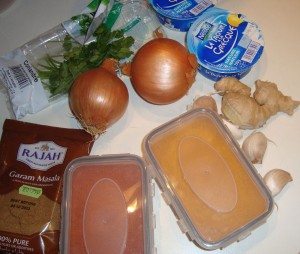 When Fraussie suggested I write a post for her blog (I’m the Aussie exchange student who appears in this blog under the name of Brainy Pianist), I really didn’t have too many ideas. “Talk about food”, she told me, “everyone loves to read about food”. Fair enough, I thought, but how can I make it a bit different? And then it hit me. When I was leaving Australia last August, never having lived away from home, and (almost) never cooking (although I am capable), most people would ask what was the one thing I was going to miss most. Beyond my family and friends, the answer would inevitably come back to a good, home-cooked meal. In my case, that’s synonymous with pretty much everything that comes out of our kitchen, but especially a good curry.
When Fraussie suggested I write a post for her blog (I’m the Aussie exchange student who appears in this blog under the name of Brainy Pianist), I really didn’t have too many ideas. “Talk about food”, she told me, “everyone loves to read about food”. Fair enough, I thought, but how can I make it a bit different? And then it hit me. When I was leaving Australia last August, never having lived away from home, and (almost) never cooking (although I am capable), most people would ask what was the one thing I was going to miss most. Beyond my family and friends, the answer would inevitably come back to a good, home-cooked meal. In my case, that’s synonymous with pretty much everything that comes out of our kitchen, but especially a good curry.
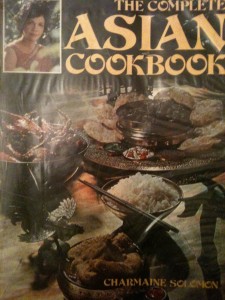 I guess in part that’s one of the greatest things coming from an Anglo-Indian/Australian background and being exposed to different cultures and cuisine. Dad grew up in India, and Mum spent hours and hours watching and learning from my grandmother (and the trusty copy of Charmaine Solomon’s The Complete Asian Cookbook). As a kid I couldn’t stand most curries, whereas my little brother was getting stuck in before he could even walk! But times have changed, and more often than not, I’ll be hankering after a good hot curry. And moving to Paris, it’s surprisingly easy to find fantastic Indian restaurants (particularly around the 10th arrondissement), and spice shops. I get a real kick ferretting around in the stores up near Gare du Nord on Rue du Faubourg Saint Denis.
I guess in part that’s one of the greatest things coming from an Anglo-Indian/Australian background and being exposed to different cultures and cuisine. Dad grew up in India, and Mum spent hours and hours watching and learning from my grandmother (and the trusty copy of Charmaine Solomon’s The Complete Asian Cookbook). As a kid I couldn’t stand most curries, whereas my little brother was getting stuck in before he could even walk! But times have changed, and more often than not, I’ll be hankering after a good hot curry. And moving to Paris, it’s surprisingly easy to find fantastic Indian restaurants (particularly around the 10th arrondissement), and spice shops. I get a real kick ferretting around in the stores up near Gare du Nord on Rue du Faubourg Saint Denis.
So, here’s a recipe for one of our family’s favourites – and it’s easy as well!
The ingredients are:
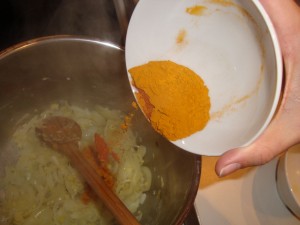 – 500g mince (I generally use beef – but you could probably use lamb as well)
– 1-2 tablespoons oil
– 1 large brown onion, finely sliced
– 2 cloves garlic, crushed
– 1 piece of fresh ginger, about 2.5cm long – peeled and chopped
– 1 teaspoon ground turmeric
– 1 teaspoon chilli powder
– ½ cup natural yoghurt
– 2 teaspoons garam masala
– 1 teaspoon salt
– Freshly chopped coriander leaves to serve
– 500g mince (I generally use beef – but you could probably use lamb as well)
– 1-2 tablespoons oil
– 1 large brown onion, finely sliced
– 2 cloves garlic, crushed
– 1 piece of fresh ginger, about 2.5cm long – peeled and chopped
– 1 teaspoon ground turmeric
– 1 teaspoon chilli powder
– ½ cup natural yoghurt
– 2 teaspoons garam masala
– 1 teaspoon salt
– Freshly chopped coriander leaves to serve
Now the method:
1) Heat oil in saucepan and fry onion until soft.
2) Add garlic and ginger and fry until onion is golden brown.
3) Add turmeric and chilli powder and fry for a few minutes. If you like, you could add some ground coriander at this point as well.
4) Add meat and fry, turning meat constantly until colour changes. Break up any large lumps of meat.
5) Stir in the yoghurt, lower the heat, cover and cook for 15 minutes. (This should be a gentle simmer)
6) Add garam masala and salt, leave the lid off, and continue cooking until meat is cooked.
7) Stir through fresh coriander and serve.
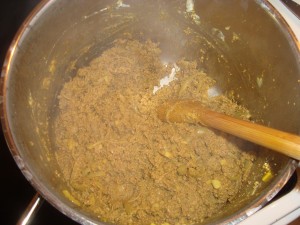 Just a couple of helpful tips: the amount of chilli powder depends a) on how hot you want the curry to be, and b) the individual chilli powder. Every powder is slightly different in its strength, and its potency also changes with age. If you’re opening a new packet, be cautious in the quantities!
Just a couple of helpful tips: the amount of chilli powder depends a) on how hot you want the curry to be, and b) the individual chilli powder. Every powder is slightly different in its strength, and its potency also changes with age. If you’re opening a new packet, be cautious in the quantities!
The final cooking stage varies, but Mum told me just to leave it as long as it takes to cook the rice.
You can also control the final consistency of the curry: if you like a lot of gravy, you can add a little water at the final stage (but be careful you don’t add too much, especially if the meat gives off a lot of fat or liquid). If you prefer a drier curry, you can increase the heat in the final stage – but watch it closely and stir frequently– with the yoghurt, the curry will have a tendency to stick to the saucepan.
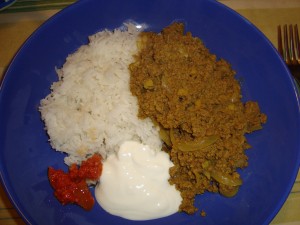 And don’t forget – if you’re increasing the quantity of meat, you mustn’t increase the amount of spices in the same proportion. For instance, cooking a kilo of mince, I would only put 1 ½ teaspoon of chilli powder – otherwise it can be very spicy!
And don’t forget – if you’re increasing the quantity of meat, you mustn’t increase the amount of spices in the same proportion. For instance, cooking a kilo of mince, I would only put 1 ½ teaspoon of chilli powder – otherwise it can be very spicy!
Serve with cooked basmati rice (I like to add some dried curry leaves while I’m cooking the rice – I can’t get the fresh ones we have in the garden back home, but dried ones give quite a lot of flavour), natural yoghurt, pappadums, and for that extra kick, a spicy Indian pickle. Bon appétit!




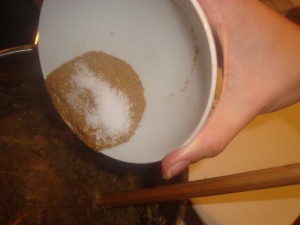
Thanks! I love fusion food too and I had been drooling over Charmaine Solomon’s book for ages until a friend of my mother’s recently found a copy in a second-hand book fair and since she already had several copies I got lucky! When I’m in my little mountain village in Italy, the thing I most miss is coriander, so to combat the coriander blues I order it from the vegetable truck a week in advance, just in case I need a fix, because no matter how many Asian, Middle Eastern or South American recipes translated into Italian try to convince us otherwise, parsley just doesn’t just the mustard as a substitute!
Your mince looks delish – and easy. Will try it very soon!
Cheers from Kiwi
Charmaine Solomon’s book was recommended to me about 30 years ago by an Australian Chinese friend. It’s been well used. I was delighted to discover that Brainy Pianist’s mother used it too! It’s even translated into French!
Thanks Allyson! You’ll have to let us know how the curry turns out. The Charmaine Solomon book has well served three generations in our family – I was looking for a copy for myself and have discovered there is a new edition coming out shortly which can be pre-ordered on Book Depository. Can’t imagine having to order coriander in advance! Although sometimes it is impossible to get in the supermarkets here too.
Coriander is called “persil arabe” and you can find it in most corner Arab shops. Chinese shops often have it too.
It’s funny that the same thing can have so many different names – in the supermarket they just call it ‘coriandre’. I asked once at the market, but apparently it was out of season – definitley good to know where else it’s readily available
I used to buy it from the Moroccan guys at my local market in the 20th arrondissement. They had it most of the year, along with absinthe, which is simply feathery silvery grey stalks that the Moroccans put into their mint tea to make “whisky berbère”. My first encounter with whisky berbère was when I let myself be convinced into entering a carpet shop in the souk in Marrachech “just to look”. I knew I was in trouble when they produced mint tea that tasted strongly of absinthe in the first 2 minutes of our being there as that’s usually the sign that negotiations are at an advanced stage. Needless to say, we left 3 hours later with a carpet per head. I’m not sure whether it was the absinthe, the sugar, the heat or the protracted negotiations, but something worked!
Goodness, I wouldn’t know what absinthe smells like! Were the carpets worth it?
Funny enough, we used to have an absinthe plant in our garden when we were little. It smells sort of powdery, musky, green and woody, as I recall.
I loved my carpet until the local dry cleaners ignored my “the vegetable dies run very easily” instructions and what was left of the faded blue bled into the other colours. I’ve still got it, along with the piece the dog bit out of it, waiting till I find a carpet repair shop. There’s one near my Mum’s place here. Just have to bring the carpet!
The carpet has goat hair woven into it and it smelled terrible when I first got it home so there is some chance that it had been used previously and not simply laid out in the sun to fade. The pattern is embroidered over the base and knotted on the back. There’s a lot of work in it, regardless of the age.
It’s like the long ones (not as long!) on the floor in this picture:
http://www.flickr.com/photos/atrium09/1746095741/
Or the Zaiane in this intro to Moroccan carpets:
http://riadzany.blogspot.co.nz/p/beginners-guide-to-moroccan-carpets.html